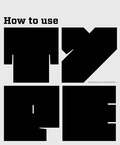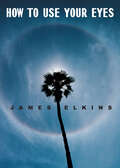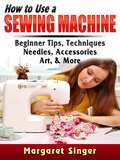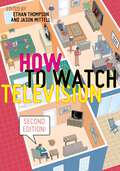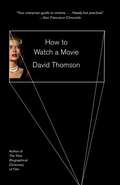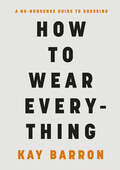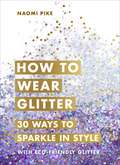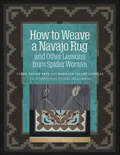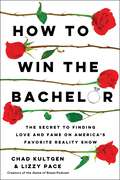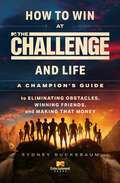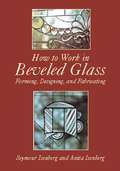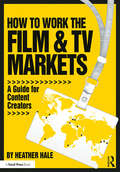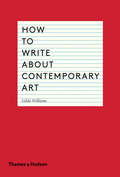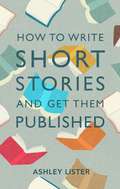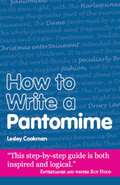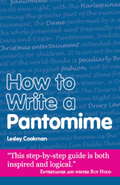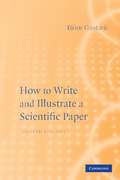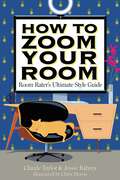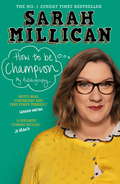- Table View
- List View
How to Use Type
by Lindsey MarshallThis book is a guide to the use of type in design for print and screen. It provides a creative, informative and practical introduction for those studying all pathways of graphic design.The authors discuss who uses type, where and when type is employed, audience and appropriateness of type and communication. The book includes basic information about type and its terminology, using typefaces, designing and communicating with type, colour and movement, experimentation with type and production issues. Throughout, examples are drawn from design for both print and screen. How to Use Type includes illustrated activities and case studies linked to key issues discussed in the text. This book offers an invaluable overview of an essential aspect of visual communication.
How to Use Your Eyes
by James ElkinsJames Elkins's How to Use Your Eyes invites us to look at--and maybe to see for the first time--the world around us, with breathtaking results. Here are the common artifacts of life, often misunderstood and largely ignored, brought into striking focus. With the discerning eye of a painter and the zeal of a detective, Elkins explores complicated things like mandalas, the periodic table, or a hieroglyph, remaking the world into a treasure box of observations--eccentric, ordinary, marvelous.
How to Use a Breadboard!
by Jody Culkin Sean Michael RaganThis full-color, illustrated handbook uses comic book-style panels to explain the basics of using a breadboard; then it walks you through ten fun and educational projects. You'll learn-by-doing as you study the circuit diagrams and colorful drawings, working your way through each project. Bonus features include an "X-Ray" drawing of the inside of the breadboard and a guide to understanding resistor color codes. A solderless breadboard is the perfect platform for learning electronics, whether at home or in the classroom, because it can be used over and over again for different circuits. With the projects in this handbook, you will learn how to use a light sensor, a potentiometer, a diode, a 555 timer, capacitors, transistors, and more! You'll also be challenged to actively figure out what else you can do with the circuits you have built.Learn how to build the following circuits:Dark DetectorLED FlasherElectric CricketBreathing LEDBanshee SirenLight TheraminBlues OrganBike Signal LightTouch SwitchLed Color OrganAs you gain experience building the circuits, you'll also learn how to read schematics - the shorthand language of electronics. The glossary provides definitions and illustrations for terms that may be unfamiliar.There's no better way to learn than by making things yourself. In this booklet you won't be handed all the answers. You'll be encouraged to experiment, and you'll be asked questions that you'll have to try to answer yourself. Get started with your breadboard experiments today.Electronics is the perfect STEM subject because it touches on all the key components - science, technology, engineering, and mathematics. Build your technical skills with this hands-on learning course!
How to Use a Sewing Machine: Tips for beginners, techniques, needles, accessories, art, and more
by Margaret SingerDo you like knitting and would like to learn how to use a sewing machine? ¡ Learn how to create beautiful patterns in no time! - Types of sewing machines. - How to install it. - What else to buy. - How to use it. - Make patterns in just a few hours. - Learn to sew. - Learn stitch patterns. - Create hats, sweaters, socks, gifts, household items, and more!
How to Watch Television, Second Edition (User's Guides to Popular Culture #3)
by Ethan Thompson Jason MittellA new edition that brings the ways we watch and think about television up to the presentWe all have opinions about the television shows we watch, but television criticism is about much more than simply evaluating the merits of a particular show and deeming it “good” or “bad.” Rather, criticism uses the close examination of a television program to explore that program’s cultural significance, creative strategies, and its place in a broader social context.How to Watch Television, Second Edition brings together forty original essays—more than half of which are new to this edition—from today’s leading scholars on television culture, who write about the programs they care (and think) the most about. Each essay focuses on a single television show, demonstrating one way to read the program and, through it, our media culture. From fashioning blackness in Empire to representation in Orange is the New Black and from the role of the reboot in Gilmore Girls to the function of changing political atmospheres in Roseanne, these essays model how to practice media criticism in accessible language, providing critical insights through analysis—suggesting a way of looking at TV that students and interested viewers might emulate. The contributors discuss a wide range of television programs past and present, covering many formats and genres, spanning fiction and non-fiction, broadcast, streaming, and cable. Addressing shows from TV’s earliest days to contemporary online transformations of the medium, How to Watch Television, Second Edition is designed to engender classroom discussion among television critics of all backgrounds.To access additional essays from the first edition, visit the "links" tab at nyupress.org/9781479898817/how-to-watch-television-second-edition/.
How to Watch a Movie
by David ThomsonFrom one of the most admired critics of our time, brilliant insights into the act of watching movies and an enlightening discussion about how to derive more from any film experience. Since first publishing his landmark Biographical Dictionary of Film in 1975 (recently released in its sixth edition), David Thomson has been one of our most provocative authorities on all things cinema. Now he offers his most inventive exploration of the medium yet: guiding us through each element of the viewing experience, considering the significance of everything from what we see and hear on-screen--actors, shots, cuts, dialogue, music--to the specifics of how, where, and with whom we do the viewing. With customary candor and wit, Thomson delivers keen analyses of a range of films from classics such as Psycho and Citizen Kane to contemporary fare such as 12 Years a Slave and All Is Lost, revealing how to more deeply appreciate both the artistry and (yes) manipulation of film, and how watching movies approaches something like watching life itself. Discerning, funny, and utterly unique, How to Watch a Movie is a welcome twist on a classic proverb: Give a movie fan a film, she'll be entertained for an hour or two; teach a movie fan to watch, his experience will be enriched forever.From the Hardcover edition.
How to Watch a Movie
by David ThomsonFrom one of the most admired critics of our time, brilliant insights into the act of watching movies and an enlightening discussion about how to derive more from any film experience. Since first publishing his landmark Biographical Dictionary of Film in 1975 (recently released in its sixth edition), David Thomson has been one of our most provocative authorities on all things cinema. Now he offers his most inventive exploration of the medium yet: guiding us through each element of the viewing experience, considering the significance of everything from what we see and hear on-screen—actors, shots, cuts, dialogue, music—to the specifics of how, where, and with whom we do the viewing. With customary candor and wit, Thomson delivers keen analyses of a range of films from classics such as Psycho and Citizen Kane to contemporary fare such as 12 Years a Slave and All Is Lost, revealing how to more deeply appreciate both the artistry and (yes) manipulation of film, and how watching movies approaches something like watching life itself. Discerning, funny, and utterly unique, How to Watch a Movie is a welcome twist on a classic proverb: Give a movie fan a film, she’ll be entertained for an hour or two; teach a movie fan to watch, his experience will be enriched forever.From the Hardcover edition.
How to Watch a Movie
by David ThomsonFrom one of the most admired critics of our time, brilliant insights into the act of watching movies and an enlightening discussion about how to derive more from any film experience. Since first publishing his landmark Biographical Dictionary of Film in 1975 (recently released in its sixth edition), David Thomson has been one of our most provocative authorities on all things cinema. Now he offers his most inventive exploration of the medium yet: guiding us through each element of the viewing experience, considering the significance of everything from what we see and hear on-screen—actors, shots, cuts, dialogue, music—to the specifics of how, where, and with whom we do the viewing. With customary candor and wit, Thomson delivers keen analyses of a range of films from classics such as Psycho and Citizen Kane to contemporary fare such as 12 Years a Slave and All Is Lost, revealing how to more deeply appreciate both the artistry and (yes) manipulation of film, and how watching movies approaches something like watching life itself. Discerning, funny, and utterly unique, How to Watch a Movie is a welcome twist on a classic proverb: Give a movie fan a film, she’ll be entertained for an hour or two; teach a movie fan to watch, his experience will be enriched forever.From the Hardcover edition.
How to Wear Everything
by Kay BarronAt last—a fun, chic, no-nonsense guide to getting dressed.What we wear matters. It matters because looking and therefore feeling like yourself is essential. Clothes can make the difference between a good day and a bad day. Clothes have the power to make your mood ten times worse or one hundred times better. Clothes should give you confidence, and never make you doubt yourself. Whether you already have a go-to look or feel overwhelmed by choice, How to Wear Everything covers where to start, what you need, and what you absolutely do not—whatever your age, body type, or budget. Highlights include: Mastering timeless classics that you will want to wear forever What to pack and (more importantly) not pack for travel Shopping thrift and vintage like a pro How to find the perfect jeans for your shape A fun, no-nonsense guide with tips and tricks from the super-stylish, including Oprah Winfrey, Sofia Richie Grainge, Sarah Jessica Parker, Monica Bellucci, Jodie Turner-Smith, Ruth E. Carter, Nicky Zimmermann and Law Roach, How to Wear Everything reveals the fashion industry's best-kept secret: getting dressed is not that hard.
How to Wear Glitter: 30 Ways to Sparkle in Style
by Naomi PikeLive life with a little more sparkle. This is your one-stop guide to glitter and how to wear it. Includes only the best biodegradable and ethical brands (please glitter responsibly!).Features 30 gorgeous step-by-step looks from all-sparkle lips to intricate eye make-up, glitter braids and beards, to full-on body art or a perfectly simple glitter lash line.Halloween, Christmas or festival season just isn't the same without a little sparkle and shimmer. Also includes glitter inspiration from the runway to Instagram, your basic eco-glitter beauty kit, fashion and accessories to complete the look, sparkling stockists and top tips from the experts, including make-up artists, drag queens, celebs, stylists and fashion designers.Grab your glitter, because you deserve to shine!
How to Weave a Navajo Rug and Other Lessons from Spider Woman
by Lynda Teller Pete Barbara Teller OrnelasNavajo blankets, rugs, and tapestries are the best-known, most-admired, and most-collected textiles in North America. There are scores of books about Navajo weaving, but no other book like this one. For the first time, master Navajo weavers themselves share the deep, inside story of how these textiles are created, and how their creation resonates in Navajo culture. Want to weave a high-quality, Navajo-style rug? This book has detailed how-to instructions, meticulously illustrated by a Navajo artist, from warping the loom to important finishing touches. Want to understand the deeper meaning? You'll learn why the fixed parts of the loom are male, and the working parts are female. You'll learn how weaving relates to the earth, the sky, and the sacred directions. You'll learn how the Navajo people were given their weaving tradition (and it wasn't borrowed from the Pueblos!), and how important a weaver's attitude and spirit are to creating successful rugs.You'll learn what it means to live in hózhó, the Beauty Way. Family stories—told by Lynda Teller Pete and Barbara Teller Ornelas, fifth-generation Navajo weavers who have been weaving since they were young girls—from seven generations of weavers lend charm and special insights. Characteristic Native American humor is not in short supply. Their contribution to cultural understanding and the preservation of their craft is priceless.
How to Win The Bachelor: The Secret to Finding Love and Fame on America's Favorite Reality Show
by Chad Kultgen Lizzy PacePerfect for fans of Bachelor Nation and Seinfeldia, an illuminating deep dive into the most successful reality TV franchise of all time—The Bachelor.Since its premiere in 2002, ABC&’s The Bachelor has become a staple of American television. Now, discover the fascinating history of the show, uncover the ins and outs of the phenomenon that has become Bachelor Nation, and take a deeper look at what separates the winners from the losers. From how best to exit the limo on Night One, to strategies for making a run for the all-important First Impression Rose, to how to avoid being labeled a villain, this clear-eyed guide illustrates the rules and strategies any would-be contestant should know. The ultimate must-read for every fan, How to Win the Bachelor gives you an inside look at the franchise where The Rose holds all the power.
How to Win at The Challenge and Life: A Champion's Guide to Eliminating Obstacles, Winning Friends, and Making That Money
by Sydney BucksbaumYou&’ve seen the rivalries. You&’ve witnessed the blood, sweat, and tears. You&’ve celebrated the champions. But what does it really take to win MTV&’s The Challenge? And what happens after the cameras stop rolling? Since 1998, MTV&’s The Challenge has tested competitors&’ physical, mental, and emotional endurance. Some go on to become Challenge legends, going down in history as players who changed the game forever. But for each champion, there are dozens more who try and fail (over and over again) to earn the title. In her time covering the show, pop culture journalist and Challenge superfan Sydney Bucksbaum has gotten to know many of the champs, gaining an insider&’s knowledge of what goes into making a winning strategy—and how difficult it is to actually pull it off. Here, she profiles twenty-one of the most popular, successful, and infamous champions and reveals not only how they won The Challenge but also how they applied the skills they learned from the experience to their personal lives and careers. From seven-time winner Johnny &“Bananas&” Devenanzio, Challenge &“Godfather&” Mark Long, OG champ Veronica Portillo, elimination beast Emily Schromm to most-improved competitors Cara Maria Sorbello and Chris &“C.T.&” Tamburello, the best in the game look back at their decades of hard work, including the euphoric highs, devastating lows, and everything in between. Eye-opening and inspiring, How to Win at The Challenge and Life is the must-have book for any and all fans looking to level up their own lives—and learn never-before-heard stories from the people who have dominated the show in every way.
How to Work in Beveled Glass: Forming, Designing, and Fabricating
by Anita IsenbergEasy-to-use, well-illustrated volume by experts explains grozzing, roughing, mitering, smoothing, polishing; joining bevels with lead or foil. Patterns in Victorian and contemporary styles for 14 projects: mirrors, lamps, hanging ornaments, panels. Plus, 6 guest artists exhibit more than 30 works. 248 black-and-white, over 30 color illustrations. Appendix. Index.
How to Work the Film & TV Markets: A Guide for Content Creators
by Heather HaleHow to Work the Film & TV Markets takes independent filmmakers, television and digital content creators on a virtual tour of the entertainment industry’s trade shows — the circulatory system of the entire global media landscape. This book highlights the most significant annual events around the world, details a dossier of all the players that frequent them and examines all the elements that drive the market value and profitability of entertainment properties. In-the-trenches insights from our modern, real-world marketplace are contextualized into immediately implementable practical advice. Make the most of your finite investments of funds, time and creative energy to optimize your odds for success within the mainstream, business-to-business circuit but learn how to select, apply and scale prudent, proven principles to drive your own Do-It-Yourself/Direct-to-the-Consuming-Crowd fundraising, distribution and promotional success. Heather Hale demystifies these markets, making them less intimidating, less confusing and less overwhelming. She shows you how to navigate these events, making them far more accessible, productive — and fun! This creative guide offers: An in-depth survey of the most significant film, TV and digital content trade shows around the world; An overview of the co-production market circuit that offers financing and development support to independent producers; An outline of the market-like festivals and key awards shows; A breakdown of who’s who at all these events — and how to network with them; Hot Tips on how to prepare for, execute and follow up on these prime opportunities; Low-budget key art samples and game plans; A social media speed tour with a wealth of audience engagement ideas. Visit the book’s space on www.HeatherHale.com for additional resources and up-to-date information on all these events.
How to Write About Contemporary Art
by Gilda WilliamsAn essential handbook for students and professionals on writing eloquently, accurately, and originally about contemporary art How to Write About Contemporary Art is the definitive guide to writing engagingly about the art of our time. Invaluable for students, arts professionals and other aspiring writers, the book first navigates readers through the key elements of style and content, from the aims and structure of a piece to its tone and language. Brimming with practical tips that range across the complete spectrum of art-writing, the second part of the book is organized around its specific forms, including academic essays; press releases and news articles; texts for auction and exhibition catalogues, gallery guides and wall labels; op-ed journalism and exhibition reviews; and writing for websites and blogs. In counseling the reader against common pitfalls--such as jargon and poor structure--Gilda Williams points instead to the power of close looking and research, showing how to deploy language effectively; how to develop new ideas; and how to construct compelling texts. More than 30 illustrations throughout support closely analysed case studies of the best writing, in Source Texts by 64 authors, including Claire Bishop, Thomas Crow, T.J. Demos, Okwui Enwezor, Dave Hickey, John Kelsey, Chris Kraus, Rosalind Krauss, Stuart Morgan, Hito Steyerl, and Adam Szymczyk. Supplemented by a general bibliography, advice on the use and misuse of grammar, and tips on how to construct your own contemporary art library, How to Write About Contemporary Art is the essential handbook for all those interested in communicating about the art of today.
How to Write Short Stories and Get Them Published
by Ashley ListerThis book will help you plot like a pro, master the art of suspense like Poe, craft captivating dialogue like Twain and - most crucially - get your short stories published.How to Write Short Stories and Get Them Published is the essential guide to writing short fiction. It takes the aspiring writer from their initial idea through to potential outlets for publication and pitching proposals to publishers. Along the journey this guide considers the most important aspects of creative writing, such as character, plot, point of view, description and dialogue. All of these areas are illustrated with examples of classic fiction, and accompanied by exercises that will help every writer hone their natural skill and talent into the ability to craft compelling short stories.
How to Write Short Stories and Get Them Published
by Ashley ListerThis book will help you plot like a pro, master the art of suspense like Poe, craft captivating dialogue like Twain and - most crucially - get your short stories published.How to Write Short Stories and Get Them Published is the essential guide to writing short fiction. It takes the aspiring writer from their initial idea through to potential outlets for publication and pitching proposals to publishers. Along the journey this guide considers the most important aspects of creative writing, such as character, plot, point of view, description and dialogue. All of these areas are illustrated with examples of classic fiction, and accompanied by exercises that will help every writer hone their natural skill and talent into the ability to craft compelling short stories.
How to Write a Historic Structure Report
by David ArbogastA one-of-a-kind, step-by-step guide to compiling an HSR--a document crucial to every professional working on a historic property. Any architect, engineer, or preservation professional renovating a historic property must be familiar with the historic structure report (HSR)--a document that evaluates all aspects of a property to minimize damage during restoration. The only book of its kind, this practical guide walks readers through the process of compiling an HSR. From gathering historical and archival data about the property to analyzing its structural, mechanical, and electrical components to assessing the state of its interior finish, including wood, masonry, and metals, this book covers all the nuts and bolts of an expertly written, informative HSR. Explaining what information should be included in each section and how investigators can work together effectively as a team to produce a comprehensive, coherent report, this handbook is one no professional should be without.
How to Write a Pantomime
by Lesley CookmanThere are thousands of pantomimes staged throughout the world every year, most of them in Britain. Most groups, whether they be amateur drama societies, schools, Women's Institutes or Village Hall committees are constantly on the lookout for something fresh and original. This is often a matter of economics, as professional pantomimes can be costly in terms of performing rights, let alone the cost of scripts. This book is aimed at those people who take part in this increasingly popular hobby, and at the writer who wishes to write a pantomime, either for a local group, or, indeed, for mass publication.
How to Write a Pantomime (Secrets to Success)
by Lesley CookmanThere are thousands of pantomimes staged throughout the world every year, most of them in Britain. Most groups, whether they be amateur drama societies, schools, Women's Institutes or Village Hall committees are constantly on the lookout for something fresh and original. This is often a matter of economics, as professional pantomimes can be costly in terms of performing rights, let alone the cost of scripts. This book is aimed at those people who take part in this increasingly popular hobby, and at the writer who wishes to write a pantomime, either for a local group, or, indeed, for mass publication.
How to Write and Illustrate a Scientific Paper (Second Edition)
by Björn GustaviiThis second edition of How to Write and Illustrate a Scientific Paper will help both first-time writers and more experienced authors, in all biological and medical disciplines, to present their results effectively. Whilst retaining the easy-to-read and well-structured approach of the previous edition, it has been broadened to include comprehensive advice on writing compilation theses for doctoral degrees, and a detailed description of preparing case reports. Illustrations, particularly graphs, are discussed in detail, with poor examples redrawn for comparison. The reader is offered advice on how to present the paper, where and how to submit the manuscript, and finally, how to correct the proofs. Examples of both good and bad writing, selected from actual journal articles, illustrate the author's advice - which has been developed through his extensive teaching experience - in this accessible and informative guide.
How to Zoom Your Room: Room Rater's Ultimate Style Guide
by Claude Taylor Jessie BahreyThe ultimate users' guide to curating your Zoom background from Room Raters, Twitter's foremost experts in on-screen décor. From the virtual office aficionados and Twitter superstars who brought the world the dreaded embarrassment of &“cord violations,&” comes a fun, informative guide for everyone who now finds themselves having to endure the endless onslaught of digital meetings and calls. Packed with beautiful how-to illustrations that demonstrate visually stunning set-ups and tips from celebrity zoom rooms, Room Rater packs an amusing punch while offering advice on how to up your game and not be embarrassed by your surroundings. Included in the book are examples from TV host Jonathan Capehart, former Obama advisor Valerie Jarrett, Senator Mazie Hirono, historian Michael Beschloss who takes readers on a tour of historic presidential rooms, and many more. Chockfull of practical advice that speaks directly to the home office user, the book offers guidance on how to create good lighting, use the perfect camera angle, get rid of clutter, add aesthetically pleasing touches, and avoid appearing as if you are in a hostage video. Whether we like it or not, the remote workplace is here to stay and this book serves as an essential guide to navigating that new normal. It&’s a valuable tool for everyone who wants to appear professional, competent, and composed.
How to be Champion: The No.1 Sunday Times Bestselling Autobiography
by Sarah MillicanHilarious, heartwarming and inspirational, this is the number 1 Sunday Times bestselling autobiography by comedian Sarah Millican. The funniest book of the year! *****'The naughtiest, helpiest, laughieoutloudiest and goodest book I've ever done reading on. Give that girl a banana!' DAWN FRENCH SARAH MILLICAN'S AUTOBIOGRAPHY WILL MAKE YOU LAUGH, FEEL NORMAL AND PROBABLY SNIFF YOUR LEGGINGS. Part autobiography, part self help, part confession, part celebration of being a common-or-garden woman, part collection of synonyms for nunny, Sarah Millican's debut book delves into her super normal life with daft stories, funny tales and proper advice on how to get past life's blips - like being good at school but not good at friends, the excitement of IBS and how to blossom post divorce. If you've ever worn glasses at the age of six, worn an off-the-shoulder gown with no confidence, been contacted by an old school bully, lived in your childhood bedroom in your thirties, been gloriously dumped in a Frankie and Benny's, cried so much you felt great, been for a romantic walk with a dog, worn leggings two days in a row even though they smelt of wee from a distance, then this is YOUR BOOK. If you haven't done those things but wish you had, THIS IS YOUR BOOK. If you just want to laugh on a train/sofa/toilet or under your desk at work, THIS IS YOUR BOOK. 'Of course Sarah Millican's book will make you laugh out loud, but there are moments where she will touch you deeply. The dirty bitch.' KATHY BURKE
How to be Champion: The No.1 Sunday Times Bestselling Autobiography
by Sarah MillicanHilarious, heartwarming and inspirational, this is the number 1 Sunday Times bestselling autobiography by comedian Sarah Millican. The funniest book of the year! *****'The naughtiest, helpiest, laughieoutloudiest and goodest book I've ever done reading on. Give that girl a banana!' DAWN FRENCH SARAH MILLICAN'S AUTOBIOGRAPHY WILL MAKE YOU LAUGH, FEEL NORMAL AND PROBABLY SNIFF YOUR LEGGINGS. Part autobiography, part self help, part confession, part celebration of being a common-or-garden woman, part collection of synonyms for nunny, Sarah Millican's debut book delves into her super normal life with daft stories, funny tales and proper advice on how to get past life's blips - like being good at school but not good at friends, the excitement of IBS and how to blossom post divorce. If you've ever worn glasses at the age of six, worn an off-the-shoulder gown with no confidence, been contacted by an old school bully, lived in your childhood bedroom in your thirties, been gloriously dumped in a Frankie and Benny's, cried so much you felt great, been for a romantic walk with a dog, worn leggings two days in a row even though they smelt of wee from a distance, then this is YOUR BOOK. If you haven't done those things but wish you had, THIS IS YOUR BOOK. If you just want to laugh on a train/sofa/toilet or under your desk at work, THIS IS YOUR BOOK. 'Of course Sarah Millican's book will make you laugh out loud, but there are moments where she will touch you deeply. The dirty bitch.' KATHY BURKE
